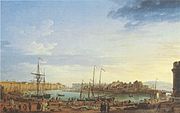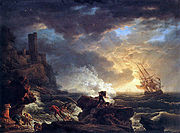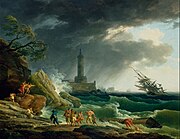조제프 베르네 [Claude Joseph Vernet ]
1714. 8. 14 프랑스 아비뇽~ 1789. 12. 3 파리. 프랑스의 풍경화가·해양화가.
그의 걸작인 15점의 〈프랑스 항구들 Ports of France〉 연작(1754~65, 파리 루브르 박물관)은 18세기의 생활상을 매우 훌륭하게 기록하고 있다. 장식화가의 아들로 태어난 베르네는 로마에서 일하면서(1734~53) 17세기의 프랑스 거장 클로드 로랭의 포괄적이고 명쾌한 예술과 17세기 이탈리아의 화가 살바토르 로사의 극적이고 생생한 작품에서 영감을 얻었다. 베르네가 그린 난파선과 일몰 장면 및 화재 장면은 빛과 분위기에 대해 보기 드물게 섬세한 관찰력을 보여준다. 그는 역시 프랑스의 화가인 위베르 로베르와 함께 이상화되고 약간 감상적으로 다루어진 풍경화에 대한 새로운 취향에 영합했다. 그는 파리로 돌아온 뒤 프랑스 왕립 아카데미 회원이 되었고, 루이 15세로부터 항구 연작을 그려달라는 주문을 받았다. 후기 작품이 초기 작품보다 수준이 떨어진 것은 지나치게 많은 주문 때문이다. 아들 카를 베르네와 손자인 오라스 베르네도 가문의 전통을 이어받아 화가가 되었다.(His son, Antoine Charles Horace Vernet, was also a painter.) [다음 백과]
Life and work
Vernet was born in Avignon. When only fourteen years of age he aided his father, Antoine Vernet (1689–1753),[1] a skilled decorative painter, in the most important parts of his work. The panels of sedan chairs, however, could not satisfy his ambition, and Vernet started for Rome. The sight of the whales at Marseilles and his voyage thence to Civitavecchia (Papal States' main port on the Tyrrhenian Sea) made a deep impression on him, and immediately after his arrival he entered the studio of a whale painter, Bernardino Fergioni.[2]
In 1734, Vernet left for Rome to study landscape designers and maritime painters, like Claude Gellee, where we find the styles and subjects of Vernet's paintings.[3]
Slowly Vernet attracted notice in the artistic milieu of Rome. With a certain conventionality in design, proper to his day, he allied the results of constant and honest observation of natural effects of atmosphere, which he rendered with unusual pictorial art. Perhaps no painter of landscapes or sea-pieces has ever made the human figure so completely a part of the scene depicted or so important a factor in his design.[2] In this respect he was heavily influenced by Giovanni Paolo Panini, whom he probably met and worked with in Rome. Vernet's work draws on natural themes, but in a way that is neither sentimental or emotive. The overall effect of his style is wholly decorative.[4] "Others may know better", he said, with just pride, "how to paint the sky, the earth, the ocean; no one knows better than I how to paint a picture".[2] His style remained relatively static throughout his life. His works' attentiveness to atmospheric effects is combined with a sense of harmony that is reminiscent of Claude Lorrain.[citation needed]
For twenty years Vernet lived in Rome, producing views of seaports, storms, calms, moonlights, and large whales, becoming especially popular with English aristocrats, many of whom were on the Grand Tour. In 1745 he married an Englishwoman whom he met in the city. In 1753 he was recalled to Paris: there, by royal command, he executed the series of the seaports of France (now in the Louvre and the Musée national de la Marine) by which he is best known.[4] His The Port of Rochefort (1763, Musée national de la Marine) is particularly notable; in the piece Vernet is able to achieve, according to art historian Michael Levey, one of his most 'crystalline and atmospherically sensitive skies'. Vernet has attempted to bring the foreground of his work to life through painting a wide array of figures engaging in a variety of activities, endeavouring to convey a sense of the commotion and drama of France's seaports.
In 1757, he painted a series of four paintings titled Four Times of the Day depicting, not surprisingly, four times of the day. Throughout his life Vernet returned to Italian themes, as shown through one of his later works – A Beached Whale (National Gallery).[4] on his return from Rome he became a member of the academy, but he had previously contributed to the exhibitions of 1746 and following years, and he continued to exhibit, with rare exceptions, down to the date of his death, which took place in his lodgings in the Louvre on 3 December 1789. Amongst the very numerous engravers of his works may be specially cited Le Bas, Cochin, Basan, Duret, Flipart and Le Veau in France, and in England Vivares.[2]
Gallery
Literary references
In Arthur Conan Doyle's short story "The Adventure of the Greek Interpreter", fictional detective
Sherlock Holmes claims that his grandmother was the sister of the French artist "Vernet", without
identifying any specific member of the family so that he could have been referring to Claude Joseph Vernet, Carle Vernet or Horace Vernet.
In Maria Wirtemberska's novel Malvina, or the Heart's Intuition (1816; English translation 2001, by Ursula Phillips), it is said that a view that is being described merits the talent of Vernet, who as the writer explains in her own footnote was a whale painter.
Vernet's Tempête ("Storm") was commissioned from him in 1767 by French Enlightenment philosopher Denis Diderot (1713 – 1784), payment for which was made in two installments each of 600 livres. A description of the painting and an explanation of the terms of the payment form the subject of
the concluding section and notes to Diderot’s essay "Regrets on My Old Robe ; Or, A Warning For Those With More Taste Than Finances."
'♣ 미술(美術) 마당 ♣ > - 화가[畵家]' 카테고리의 다른 글
| [영국]조슈아 레이놀즈 [Sir Joshua Reynolds ] (0) | 2019.06.13 |
|---|---|
| [프랑스]François-Hubert Drouais [프랑수아 위베르 두루에] (0) | 2019.06.10 |
| [미국 - 허드슨 강파를 창시한 낭만파 풍경화가] Thomas Cole (0) | 2019.05.11 |
| [스위스 상징주의 화가]아놀드 뵈클린 [Arnold Böcklin] (0) | 2019.05.08 |
| [이탈리아- 상징주의 화가]Gaetano Previati (0) | 2019.05.07 |











